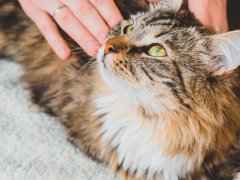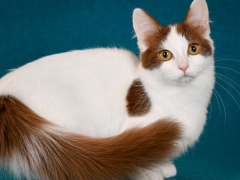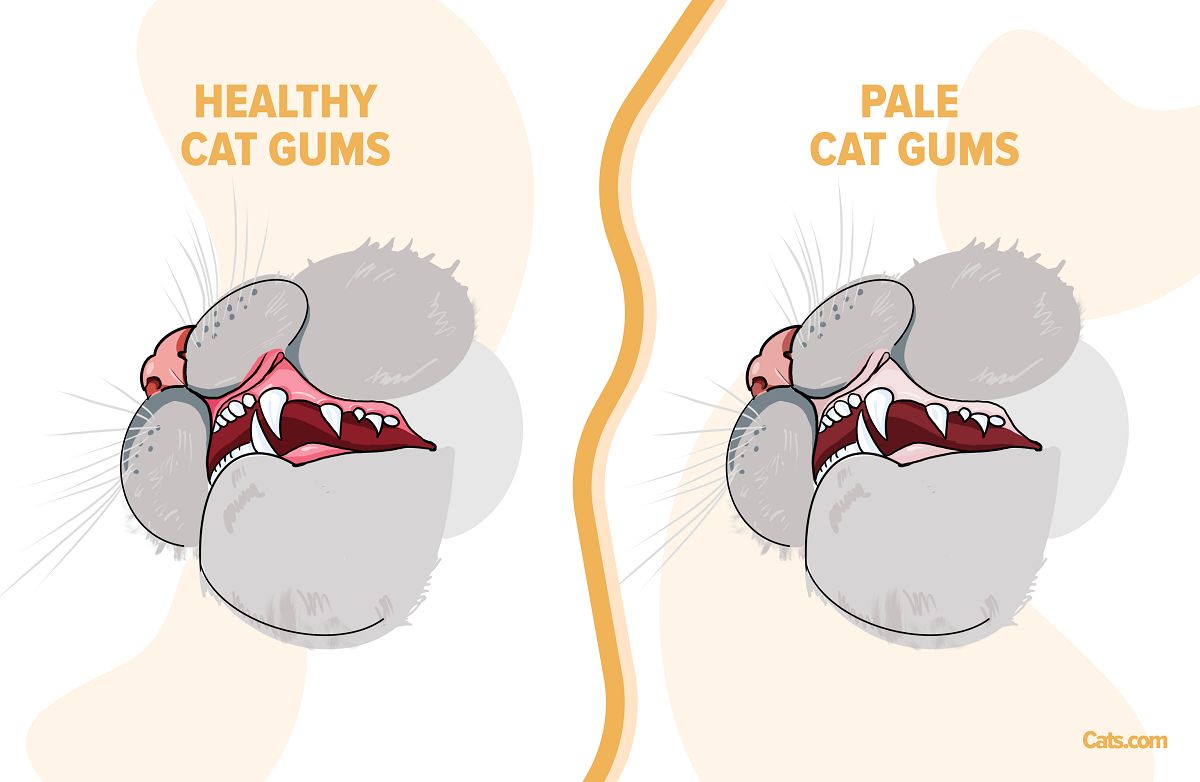
If you see pale gums in your cat, it can represent a very serious medical concern. In this article, you’ll learn some reasons cats can develop pale gums, how to recognize abnormal gum color, how veterinarians may treat these conditions, and some frequently asked questions.
How Do I Know if My Cat’s Gums Are Pale?
Normally, a cat’s gums should be a light shade of pink, just like ours. Gums are also called mucous membranes, which is a tissue type that is soft, moist, and typically pink. Other examples include the lining of the digestive tract, lungs, and nose.
Mucus membranes like the gums have lots of healthy blood flow through them normally. If there are changes to the characteristics of blood or blood flow, the appearance of the gums can reflect these changes. That’s why the gums can be considered a “window to health”.
If the normal pink color of healthy cat gums changes to more of a whitish appearance, the gums are considered pale. This appearance can range from pale with just a hint of pink left to complete blanched white.
Also Read: Dental Disease In Cats: Causes, Symptoms, & Treatment
Possible Causes of Pale Gums in Cats
Changes to the gums reflect changes in the makeup and components of blood as well as blood flow. There are several underlying causes that can contribute to these changes.
1. Anemia
Anemia is the term for when the body does not have adequate numbers of red blood cells. This can be from internal or external loss of blood, but can also occur when the body’s ability to make new red blood cells is affected, or if the body attacks its own blood cells.
Viral infections like feline leukemia virus (FeLV) and feline immunodeficiency virus (FIV) can lead to conditions that interfere with normal red blood cell production. Certain types of cancers can as well.
Infections with the bacterial organisms Mycoplasma (previously known as Hemobartinella) which are transmitted by flea bites can cause feline infectious anemia where the body attacks red blood cells colonized by the bacteria.
Also Read: Cat Blood Transfusions: Procedure, Cost, Success Rate, & Recovery
2. Shock
Physical shock (as opposed to psychological shock) occurs when the body is not receiving adequate blood flow to its vital organs. There are a few different types of shock and they can happen for different reasons. Some common underlying causes include severe dehydration, heat stroke, physical trauma, blood loss, severe allergic reactions, and severe blood-borne infections.
3. Heart Disease
There are a couple of different types of heart disease that can affect cats, but they can all contribute to changes in blood flow, blood pressure, and affect blood supply to tissues. This is especially the case during a heart disease crisis like congestive heart failure (CHF).
4. Blood loss
We often think of blood loss as occurring secondary to trauma but other causes can include infections from parasites like fleas and intestinal worms.
Internal blood loss can also occur. Trauma can lead to internal bleeding. While less common in cats vs. dogs, a cancerous tumor can rupture and bleed. Disorders of blood clotting can lead to spontaneous bleeding with risk increased by exposure to rodenticides or to mice/rats killed by rodenticides.
5. Kidney Disease
The kidneys are involved in important body processes other than just producing urine. They are also involved in blood pressure regulation and red blood cell production. Kidney failure or dysfunction can lead to changes in blood pressure, poor blood circulation and decreased production of red blood cells.
Also Read: What’s The Best Food For Cats With Kidney Disease?
When to Call the Vet
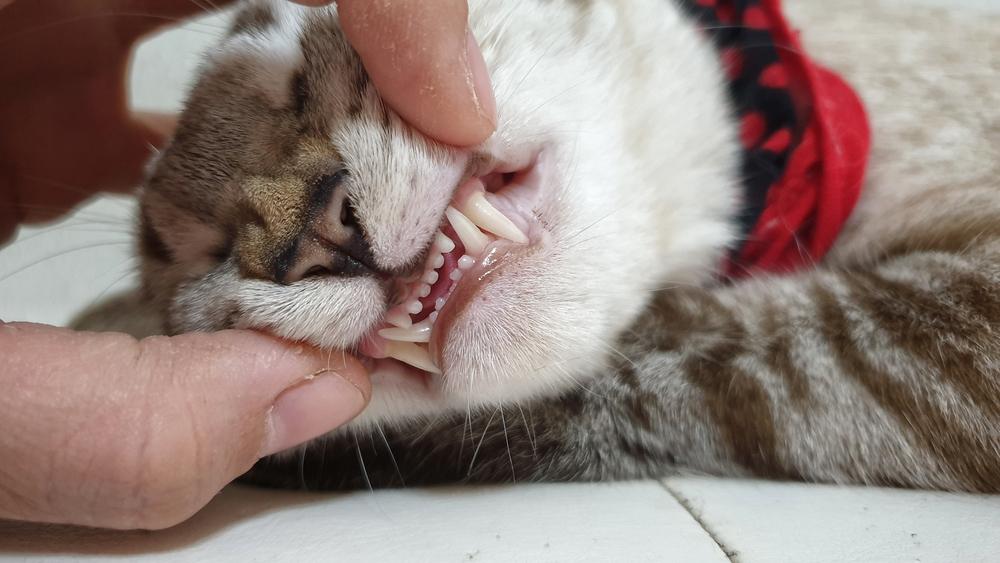
Very pale/white gums in a cat can indicate a serious and urgent health concern
Gums may become a little bit more pale in cases of stress or mild dehydration. Slight changes to the shade of pink of your cat’s gums may not be a reason to panic, especially if your kitty is otherwise acting and behaving normally at home.
Most cats with truly pale gums will be acting abnormally in other ways. This may include signs of lethargy, strange breathing, decreased appetite, vomiting and diarrhea, or signs of pain.
If you are ever unsure if your cat’s gums are pale or if other signs your cat is showing are in any way related, it’s always better to be safe than sorry and get a same day appointment with your veterinarian.
If your cat’s gums are very obviously pale or white, and especially if other abnormal symptoms of illness are present, this should be treated as a medical emergency. A life-threatening condition may be present.
Also Read: 11 Signs That You Need to Get Your Cat To the Emergency Room
Other Gums Colors in Cats and What They Mean
In addition to pale gums, there are other colors the gums may take on that are additional indicators in the “window to health”.
1. Blue/Gray
This appearance can indicate poor oxygenation of the blood, which can be called hypoxia or cyanosis. This more often occurs in cases of severe lung/airway disease or an airway obstruction where a cat cannot breathe in enough oxygen. This may occur in cases of congestive heart failure, where fluid build-up in or around the lungs is leading to poor oxygen intake. Cats with glue/grey gums commonly also show signs of respiratory distress, such as open-mouth breathing, panting or increased effort when breathing.
2. Red
Bright “brick red” gums indicate an immediate health emergency as well. This occurs when blood is pooling in the small capillary vessels. Common causes include heat stroke as well as a severe blood borne infection (sepsis or endotoxemia).
This appearance should not be confused with gingivitis, which is inflammation of the gums due to dental disease. The difference is that gingivitis typically involves redness only near the gumline and is often accompanied by tartar and calculus build up on the teeth.
Sometimes, severe gingivitis may be more extensive. Inflammation may extend to other areas of the mouth, which is then termed stomatitis or gingivostomatitis. It may be difficult for the average pet parent to tell the difference between oral inflammation and “brick red” gums that indicate an emergency, but your veterinarian can provide a complete assessment and determine the nature of what you’re seeing.
3. Yellow
When gums take on a yellow appearance, this is termed icterus or jaundice. Jaundice in cats occurs when bilirubin, a yellow pigment, builds up in the bloodstream. Bilirubin is a breakdown product of red blood cells which passes through the liver and is excreted in bile.
Jaundice can occur when there is an issue with liver or biliary function. But it can also occur if red blood cells are being broken down abnormally by the body. This can occur with a condition called hemolytic anemia, when the body’s immune system attacks and destroys its own red blood cells.
Jaundice/icterus should always be considered a medical emergency whether it appears suddenly or occurs more slowly over time, as it always indicates a serious underlying medical concern that needs to be addressed as soon as possible.
4. Black/Pigmentation (Lentigo)
Black pigmentation can be normal on the gums of some cats, especially those with orange fur, like orange tabbies. This condition is called lentigo simplex, which is also responsible for orange tabbies having freckles on their noses and ears as well.
Lentigo simplex involves the accumulation of black-pigmented melanocytes that cause this freckled appearance and is normal for these cats. It is not the same as melanoma, a type of cancer, although the spots may change in appearance with age over time.
Also Read: Dental Disease In Cats: Causes, Symptoms, & Treatment
Other Abnormalities of Gums
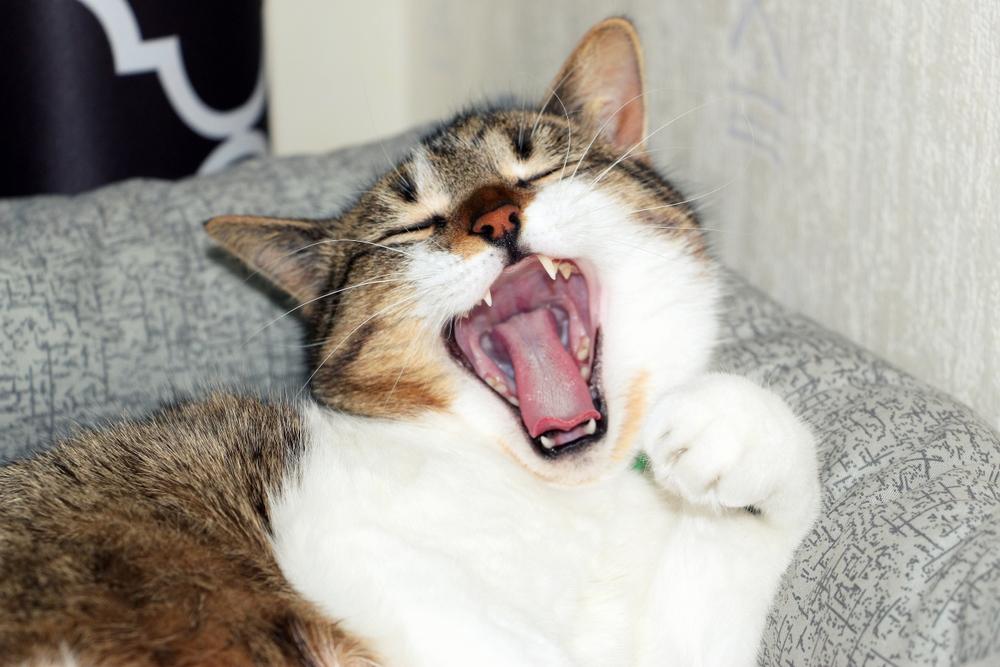
Healthy cat gums are pale pink, moist, and blanch when you press a finger against them.
Other than color, there are two other parameters that veterinarians routinely check on the gums.
1. Capillary Refill Time
The first is called capillary refill time (CRT). When gentle pressure is applied to pink gums with a finger, they will immediately blanch or turn pale in that one spot. When released, that spot should normally regain its pink appearance almost immediately.
If it takes more than 2 seconds for that area of the gums to regain its pink appearance, this is called a delayed capillary refill time. A delay indicates poor circulation. This can most commonly occur with dehydration but can occur with shock and other conditions affecting circulation as well.
2. Moisture
Since the gums are mucous membranes, they should always be moist. If they are tacky or even dry, this can indicate poor hydration. Veterinarians often use this parameter when assessing a pet that has been having vomiting or diarrhea or is suffering from heat-related injury, to determine how bad dehydration may be.
You can use these parameters at home in addition to gum color to get a generalized picture of health for your cat. When looked at together, color, moisture, and CRT of the gums can all be helpful to determine the urgency of a medical concern.
Treating Pale Gums in Cats
When you bring your cat to the veterinarian with a concern of pale gums, your vet will first fully examine your cat to combine the appearance of the gums with other exam parameters, like heart rate, respiratory rate, temperature, and energy level.
If a medical concern related to pale gums is present, your vet will advise further testing with bloodwork. Bloodwork checks for the presence of anemia, infection, and the function of major organs like the liver and kidneys. An x-ray and/or ultrasound may also be advised to assess for internal changes that could explain why your cat’s gums are pale.
From there, treatment can depend on what the findings are. An extremely low red blood cell concentration from blood loss may require a blood transfusion to get a cat stable enough for further treatment.
Medications including steroids, antibiotics, and immunosuppressive medications may be indicated depending on what the findings are and the underlying cause of an anemia.
Surgery may only be indicated in some cases of severe injury or trauma, or if a mass inside the body is contributing to internal bleeding.
Patients with pale gums due to shock from dehydration or heat-related injury will require intravenous fluid therapy to rehydrate the body and re-establish good blood pressure and circulation. Other medications can be required in more serious cases. More serious situations, especially advanced cases of heat stroke, often need multiple days in the hospital for full recovery.
Also Read: Cat Vomiting Blood: Causes & Treatment
Prevention of Pale Gums in Cats
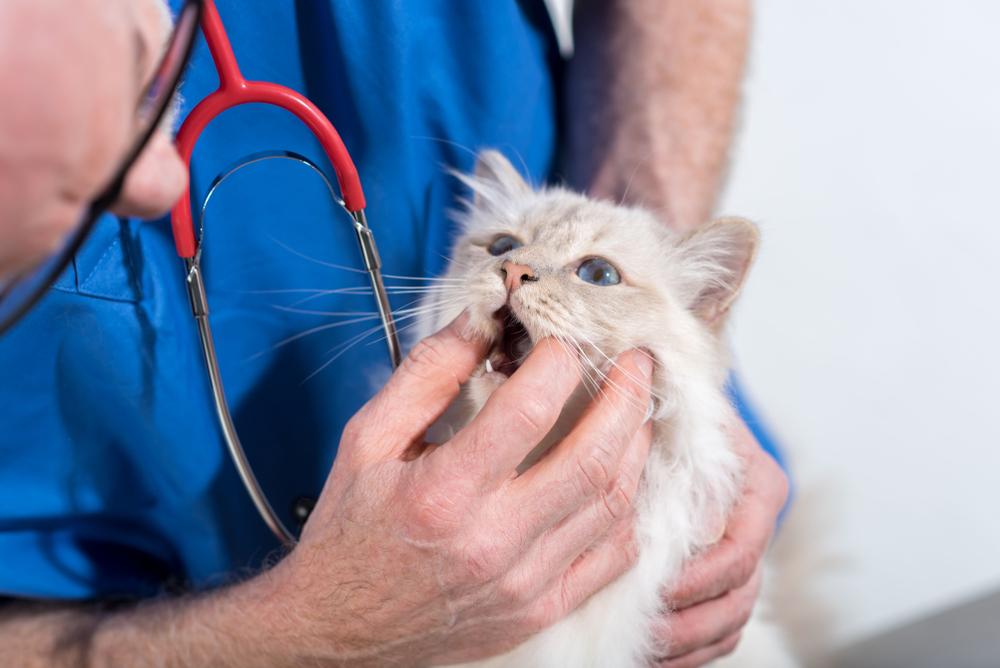
Regular vet check ups, preventative care and a safe environment are all excellent ways to keep cats safe and healthy
Conditions causing pale gums in cats are not always fully preventable. Conditions that are preventable include causes like trauma and heat-related injury. Outdoor cats can be at higher risk for these types of causes given their regular exposure to the outdoor environment, risk for vehicular trauma, and getting into fights with other animals.
Risk for acquiring feline leukemia virus (FeLV) and feline immunodeficiency virus (FIV) is greatest for outdoor cats in close contact with other outdoor cats, especially when fighting between cats occurs.
Here are some guidelines to help reduce risk as much as possible for most of these conditions.
- Reduce Risk Of Heat Stroke: Provide your cat with access to shade and cool water at all times. Never leave your cat in a vehicle when temperatures outside exceed 50-60 degrees F.
- Reduce Risk Of Trauma: Keeping your cat indoors greatly reduces the risk for accidents and injury, especially from vehicular trauma and fights with other animals. If your cat craves outdoor activity, consider training them to walk on a leash or utilizing one of the many outdoor playpens or enclosures that are available.
- FeLV/FIV: Kittens can acquire infection with these viruses from their mom. Test kittens for FeLV/FIV around 8 weeks and again after 6 months. Outdoor cats interacting often with other outdoor cats should be vaccinated for FeLV. There is no routinely recommended vaccine for FIV, but outdoor cats should be tested at least annually.
- Preventive Care With Regular Checkups: Regular exams and annual labwork (biannual for senior cats over the age of 7) can help detect underlying causes contributing to pale gums in cats early on, potentially before a medical crisis occurs. This can include assessments of heart function, blood pressure, liver and kidney function.
Also Read: Feline Leukemia Vaccine: Cost, Schedule & Side Effects
Conclusion
Pale gums in cats can represent a true medical emergency, especially if your kitty is showing other abnormal signs and behaviors at home. It may be difficult for some folks to tell if subtle changes to gum color are occurring or are related to other things they’re seeing. If there is ever concern for pale gums in your cat, it is always best to have a veterinary exam to assess whether a true problem exists and what treatment may be needed.
Also Read: Common Cat Viruses: Seven Types
-
Brooks, W. Flea Anemia in Cats and Dogs. Veterinary Partner. Revised/reviewed April 1, 2023. Accessed June 8, 2023. https://veterinarypartner.vin.com/default.aspx?pid=19239&id=4951428
-
Bellows, J. Gingivostomatitis in Cats. Veterinary Partner. Reviewed/revised June 17, 2016. Accessed June 8, 2023. https://veterinarypartner.vin.com/default.aspx?pid=19239&id=4951303
-
Brooks, W. Immune Mediated Hemolytic Anemia (IMHA) in Dogs and Cats. Veterinary Partner. Reviewed/revised January 31, 2023. Accessed June 8, 2023. https://veterinarypartner.vin.com/default.aspx?pid=19239&id=4951868
-
Brooks, W. Infectious Anemia in Cats. Veterinary Partner. Reviewed/revised November 22, 2022. Accessed June 8, 2023. https://veterinarypartner.vin.com/default.aspx?pid=19239&id=4952073
-
Brooks, W. Renal Anemia, or Inadequate Red Blood Cells, in Dogs and Cats. Veterinary Partner. Reviewed/revised February 14, 2023. Accessed June 8, 2023. https://veterinarypartner.vin.com/default.aspx?pid=19239&id=4952655
-
What Does a Dark Spot on a Cat’s Nose Mean? Bechewy. Updated January 20, 2021. Accessed June 7, 2023. https://be.chewy.com/what-does-a-dark-spot-on-a-cats-nose-mean/


